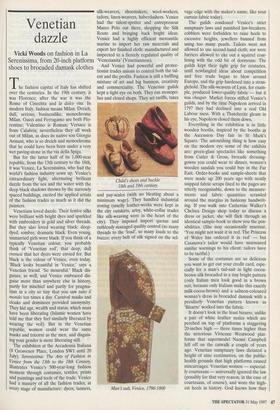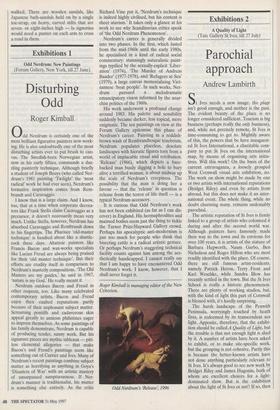Venetian dazzle
Yield Woods on fashion in La Serenissima, from 20-inch platform shoes to brocaded damask clothes The fashion capital of Italy has shifted over the centuries. In the 19th century, it was Florence; after the war it was the Rome of Cinecitta and la dolce vita. In modern Italy, fashion means Milan. Dreich, dull, serious, businesslike, monochrome Milan. Gucci and Ferragamo are both Flo- rentine; Valentino is Roman; Versace is from Calabria; nevertheless they all work out of Milan, as does its native son Giorgio Armani, who is so dreich and monochrome that he could have been born under a very wet paving-stone in the via della Spiga.
But for the latter half of its 1,000-year republic, from the 13th century to the 18th, it was Venice, La Serenissima, who had the world's fashion industry sewn up. Venice's extraordinary light, alternating brilliant dazzle from the sea and the water with the deep black shadows thrown by the narrowly spaced buildings, excited the applied artists of the fashion trades as much as it did the painters.
Venetians loved dazzle. Their festive silks were brilliant with bright dyes and sparkled with embroidery in gold and silver threads. But they also loved wearing black: deep- dyed, sombre, dramatic black. Even young, unmarried girls wore black. If you think of a typically Venetian colour, you probably think of 'Venetian red', that deep, dull cremesi that her dyers were envied for. But black is the colour of Venice, even today. `Black looks beautiful in Venice,' says a Venetian friend. 'So mournful.' Black dis- guises, as well, and Venice embraced dis- guise more than anywhere else in history, partly for mischief and partly for pragma- tism in a city so tiny that you saw tutto it mondo ten times a day. Carnival masks and cloaks and dominoes provided anonymity. They hid age, wealth and status, which must have been liberating (Islamic women have told me that they feel similarly liberated by wearing the veil). But in the Venetian republic, women could wear the same masks and tricorni as the men, and disguis- ing your gender is more liberating still.
The exhibition at the Accademia Italiana (8 Grosvenor Place, London SW1 until 20 July), Serenissima: The Arts of Fashion in Venice from the 13th to the 18th Century, Illustrates Venice's 500-year-long fashion moment through costumes, textiles, prints and paintings and tools of the trade. Venice had a mastery of all the fashion trades, at every stage of manufacture: dyers, tanners, silk-weavers, shoemakers, wool-workers, tailors, linen-weavers, haberdashers. Venice had the talent-spotter and entrepreneur Marco Polo out there, shopping the Silk Route and bringing back bright ideas. Venice had a highly efficient mercantile marine to import her raw materials and export her finished cloth: manufactured and inspected to a fiercely regulated quality of Wenezianita' (Venetianness).
And Venice had powerful and protec- tionist trades unions to control both the tal- ent and the profits. Fashion is still a baffling mixture of art and big business, creativity and commerciality. The Venetian guilds kept a tight eye on both. They ran monopo- lies and closed shops. They set tariffs, taxes Child's shoes and buckle 18th and 19th century and pay-scales (with no bleating about a minimum wage). They handled industrial zoning (smelly leather-works were kept in the city outskirts, artsy, white-collar trades like silk-weaving were in the heart of the city). They imposed import quotas and ruthlessly managed quality control (so many threads to the 'load', so many loads to the brazzo; every bolt of silk signed on the sel- Man's suit, Venice, 1790-1800 vage edge with the maker's name, like your curtain fabric today).
The guilds condoned Venice's strict sumptuary laws and punished law-breakers; cobblers were forbidden to raise heels to excessive heights, jewellers banned from using too many pearls. Tailors were not allowed to use second-hand cloth; nor were furriers allowed to eke out a squirrel coat- lining with the odd bit of dormouse. The guilds kept their tight grip for centuries, until newfangled ideas about competition and free trade began to blow around Europe, and the grip hardened into a stran- glehold. The silk-weavers of Lyon, for exam- ple, produced lower-quality fabric — but it was cheaper. Market forces stifled Venice's guilds, and by the time Napoleon arrived in 1797 they had declined into a real Old Labour mess. With a Thatcherite gleam in his eye, Napoleon closed them down.
Everything in the exhibition is in little wooden booths, inspired by the booths at the Ascension Day fair in St Mark's Square. The astonishing thing is how easy on the modern eye some of the exhibits are: green-glass spectacles like something from Cutler & Gross, brocade dressing- gowns you could wear to dinner, women's wooden sandals you could buy in the Far East. Order-books and sample-sheets that were made up 200 years ago with neatly snipped fabric scraps fixed to the pages are utterly recognisable, down to the measure- ments and fabric quantities scrawled around the margins in fashiony handwrit- ing. If you walk into Catherine Walker's Chelsea Design shop today to discuss a dress or jacket, she will flick through an identical sample-book to show you the pos- sibilities. (She may occasionally murmur, `You might not want it in red. The Princess of Wales has ordered it in red' — but Casanova's tailor would have murmured similar warnings to his client: tailors have to be tactful.) Some of the costumes are so delicious you want to get out your credit card, espe- cially for a man's tail-suit in light cocoa- brown silk brocaded in a tiny bright pattern (only Italian men look good in a brown suit, because only Italians make this exactly milk-cocoa-brown) and a salmon-coloured woman's dress in brocaded damask with a peculiarly Venetian pattern known as `Bizarre' worked into the fabric.
It doesn't look in the least bizarre, unlike a pair of white leather mules which are perched on top of platforms a staggering 20-inches high — three times higher than the notorious Vivienne Westwood plat- forms that supermodel Naomi Campbell fell off on the catwalk a couple of years ago. Venetian sumptuary laws dictated a height of nine centimetres, on the public- health grounds that high platforms caused miscarriages. Venetian women — especial- ly courtesans — universally ignored the law (possibly for that very reason, in the case of courtesans, of course), and wore the high- est heels in history. God knows how they walked. There are wooden sandals, like Japanese bath-sandals held on by a single toe-strap, on heavy, curved stilts that are seven- or eight-inches high — la signorina would need a punter on each arm to cross a road in them.



































































 Previous page
Previous page